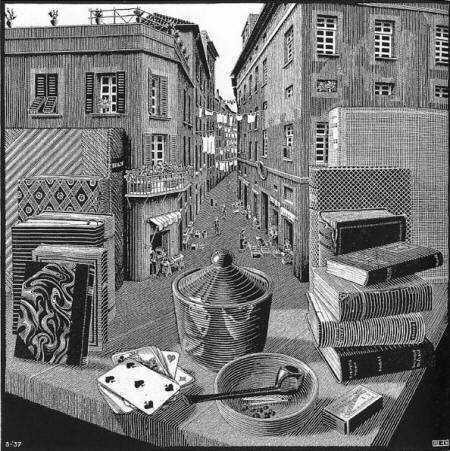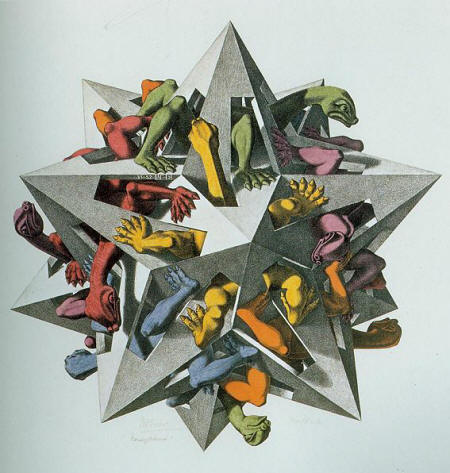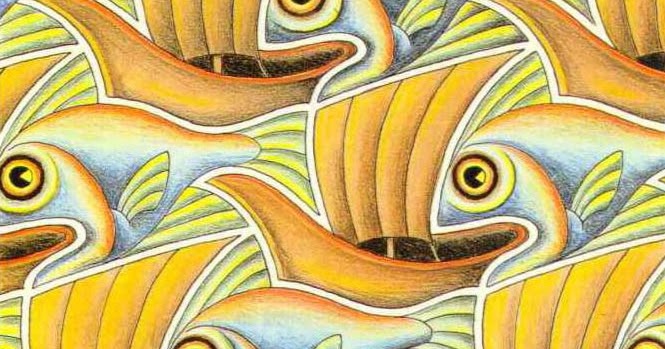-


 M.C. Escher
M.C. Escher
Dutch
Artist
Maurits Cornelis Escher, or "Mauk" as he came to be nicknamed, was born in Leeuwarden, Holland in 1898. He was the fourth and youngest son of a civil engineer. After 5 years the family moved to Arnhem where Escher spent most of his youth. After failing his high school exams, M.C. Escher ultimately was enrolled in the School for Architecture and Decorative Arts in Haarlem. While M.C. Escher was still in school his family planned for him to follow his father's career of architecture, but poor grades and an aptitude for drawing and design eventually led him to a career in the graphic arts.
M.C. Escher is one of the world's most famous graphic artists. He created unique and fascinating works of art that explore and exhibit a wide range of mathematical ideas. M.C. Escher is most famous for his so-called impossible structures, such as "Ascending and Descending", "Relativity", his Transformation Prints, such as "Metamorphosis I", "Metamorphosis II" and "Metamorphosis III", "Sky & Water I" or "Reptiles". Apart from being a graphic artist, M.C. Escher illustrated books, designed tapestries, postage stamps and murals. In "Ascending and Descending" lines of people ascend and descend stairs in an infinite loop, on a construction which is impossible to build and possible to draw only by taking advantage of quirks of perception and perspective.
"Only those who attempt the absurd will achieve the impossible. I think it's in my basement... let me go upstairs and check."
M.C. Escher was a man studied and greatly appreciated by respected mathematicians, scientists and crystallographers yet he had no formal training in math or science. M.C. Escher was a humble man who considered himself neither an artist or mathematician. Intricate repeating patterns, mathematically complex structures, spatial perspectives all require a "second look". In Escher's work what you see the first time is most certainly not all there is to see. During his lifetime M.C. Escher made 448 lithographs, woodcuts and wood engravings and over 2000 drawings and sketches.
Escher's first print of an impossible reality was a woodcut print called "Still Life and Street" in March of 1937. It depicts a table with books and other items, which blends into a street scene in the background. This image is a classic example of Escher’s plays on perspective. In it, the horizontal plane of the table continues into the distance to become the street, and the rows of books on the table are seen to lean against the tall buildings that line the street.
His artistic expression was created from images in his mind, rather than directly from observations and travels to other countries. "What I give form to in daylight is only one per cent of what I have seen in darkness."
M.C. Escher worked primarily in the media of lithographs and woodcuts, though the few mezzotints he made are considered to be masterpieces of the technique. In his graphic art,
M.C. Escher portrayed mathematical relationships among shapes, figures and space. Additionally, M.C. Escher explored interlocking figures using black and white to enhance different dimensions. Integrated into his prints were mirror images of cones, spheres, cubes, rings and spirals. Tessellations are arrangements of closed shapes that completely cover the plane without overlapping and without leaving gaps. Typically, the shapes making up a tessellation are polygons or similar regular shapes, such as the square tiles often used on floors.
M.C. Escher's work went almost unnoticed until the 1950’s, but by 1956 he had given his first important exhibition, was written up in Time magazine, and acquired a world-wide reputation. M.C Escher was awarded the Knighthood of the Order of Orange Nassau in 1955. Subsequently he regularly designed art for dignitaries around the world. An asteroid, 4444 Escher, was named in his honor in 1985. M.C. Escher played with architecture, perspective and impossible spaces. His art continues to amaze and wonder millions of people all over the world. In his work we recognize M.C. Escher's keen observation of the world around us and the expressions of his own fantasies. M.C. Escher shows us that reality is wondrous, comprehensible and fascinating.